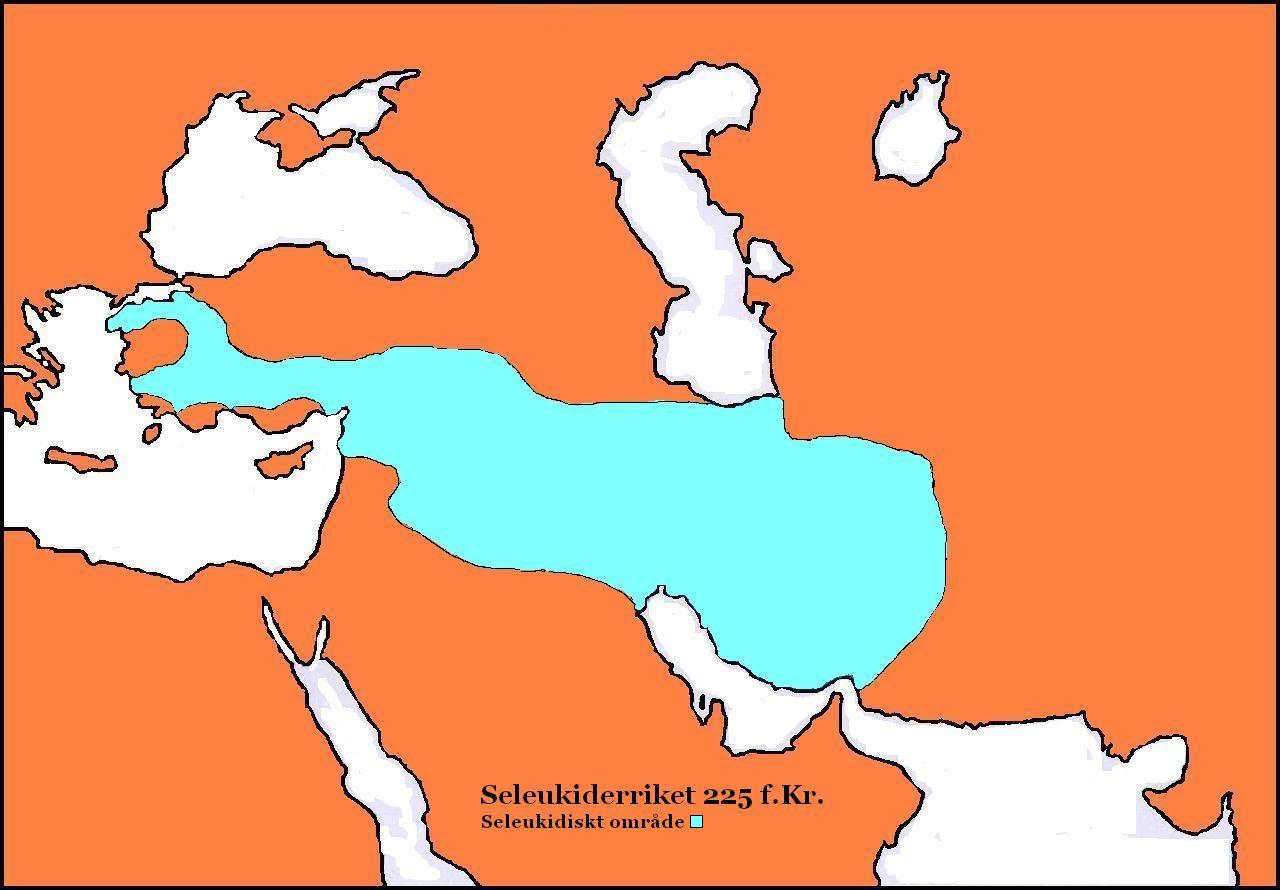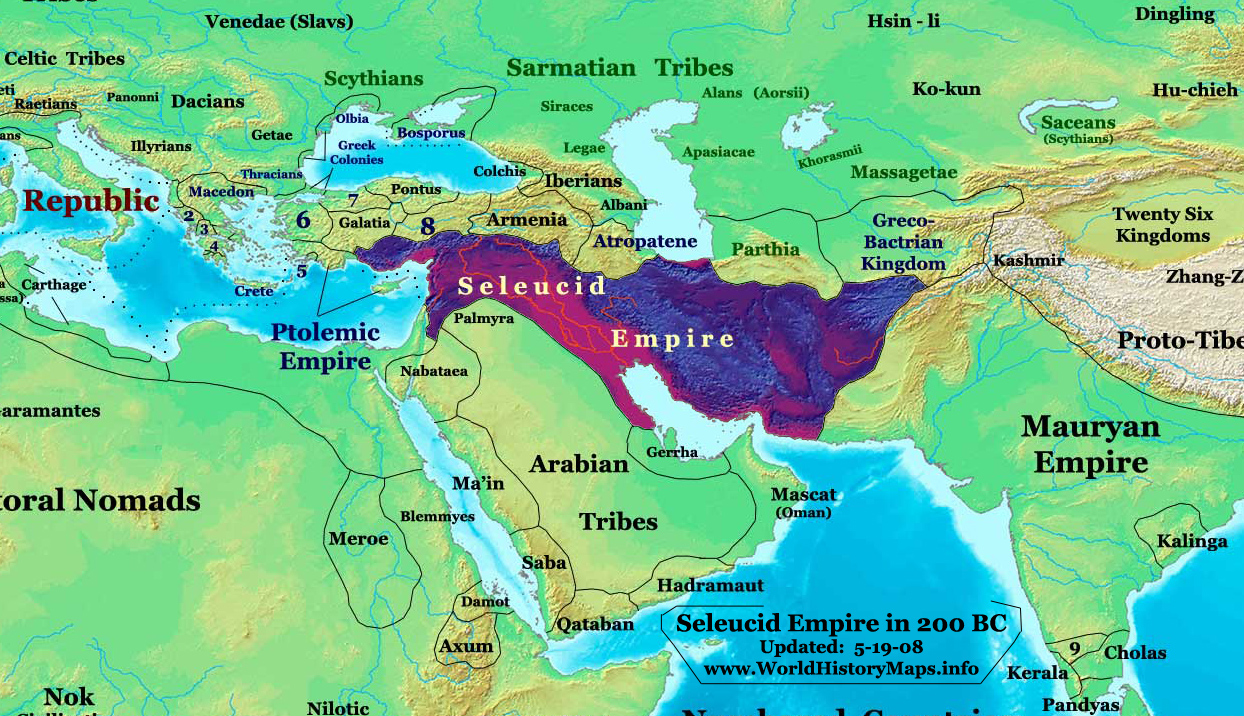|
Antiochus III The Great
Antiochus III the Great (; grc-gre, Ἀντίoχoς Μέγας ; c. 2413 July 187 BC) was a Greek Hellenistic king and the 6th ruler of the Seleucid Empire, reigning from 222 to 187 BC. He ruled over the region of Syria and large parts of the rest of western Asia towards the end of the 3rd century BC. Rising to the throne at the age of eighteen in 222 BC, his early campaigns against the Ptolemaic Kingdom were unsuccessful, but in the following years Antiochus gained several military victories and substantially expanded the empire's territory. His traditional designation, ''the Great'', reflects an epithet he assumed. He also assumed the title ''Basileus Megas'' (Greek for "Great King"), the traditional title of the Persian kings. A militarily active ruler, Antiochus restored much of the territory of the Seleucid Empire, before suffering a serious setback, towards the end of his reign, in his war against Rome. Declaring himself the "champion of Greek freedom against Roman dominat ... [...More Info...] [...Related Items...] OR: [Wikipedia] [Google] [Baidu] |
Great King
Great king, and the equivalent in many languages, refers to historical titles of certain monarchs, suggesting an elevated status among the host of kings and princes. This title is most usually associated with the '' shahanshah'' (shah of shahs, i.e. king of kings, indeed translated from Greek as ''basileus tōn basileōn'', later adopted by the Byzantine emperors) of Persia under the Achaemenid dynasty whose vast empire in Asia lasted for 200 years up to the year 330 BC, which was later adopted by successors of the Achaemenid Empire whose monarchial names were also succeeded by "the great". In comparison, " high king" was used by ancient rulers in Great Britain and Ireland, as well as Greece. In the 2nd millennium BCE Near East, there was a tradition of reciprocally using such addresses between powers, as a way of diplomatically recognizing each other as an equal. Only the kings of countries who were not subject to any other king and powerful enough to draw the respect from the ... [...More Info...] [...Related Items...] OR: [Wikipedia] [Google] [Baidu] |
Hellenistic Period
In Classical antiquity, the Hellenistic period covers the time in Mediterranean history after Classical Greece, between the death of Alexander the Great in 323 BC and the emergence of the Roman Empire, as signified by the Battle of Actium in 31 BC and the conquest of Ptolemaic Egypt the following year. The Ancient Greek word ''Hellas'' (, ''Hellás'') was gradually recognized as the name for Greece, from which the word ''Hellenistic'' was derived. "Hellenistic" is distinguished from "Hellenic" in that the latter refers to Greece itself, while the former encompasses all ancient territories under Greek influence, in particular the East after the conquests of Alexander the Great. After the Macedonian invasion of the Achaemenid Empire in 330 BC and its disintegration shortly after, the Hellenistic kingdoms were established throughout south-west Asia ( Seleucid Empire, Kingdom of Pergamon), north-east Africa ( Ptolemaic Kingdom) and South Asia ( Greco-Bactrian Kingdom, Indo-Gree ... [...More Info...] [...Related Items...] OR: [Wikipedia] [Google] [Baidu] |
Anatolia
Anatolia, tr, Anadolu Yarımadası), and the Anatolian plateau, also known as Asia Minor, is a large peninsula in Western Asia and the westernmost protrusion of the Asian continent. It constitutes the major part of modern-day Turkey. The region is bounded by the Turkish Straits to the northwest, the Black Sea to the north, the Armenian Highlands to the east, the Mediterranean Sea to the south, and the Aegean Sea to the west. The Sea of Marmara forms a connection between the Black and Aegean seas through the Bosporus and Dardanelles straits and separates Anatolia from Thrace on the Balkan peninsula of Southeast Europe. The eastern border of Anatolia has been held to be a line between the Gulf of Alexandretta and the Black Sea, bounded by the Armenian Highlands to the east and Mesopotamia to the southeast. By this definition Anatolia comprises approximately the western two-thirds of the Asian part of Turkey. Today, Anatolia is sometimes considered to be synonymous w ... [...More Info...] [...Related Items...] OR: [Wikipedia] [Google] [Baidu] |
Persia
Iran, officially the Islamic Republic of Iran, and also called Persia, is a country located in Western Asia. It is bordered by Iraq and Turkey to the west, by Azerbaijan and Armenia to the northwest, by the Caspian Sea and Turkmenistan to the north, by Afghanistan and Pakistan to the east, and by the Gulf of Oman and the Persian Gulf to the south. It covers an area of , making it the 17th-largest country. Iran has a population of 86 million, making it the 17th-most populous country in the world, and the second-largest in the Middle East. Its largest cities, in descending order, are the capital Tehran, Mashhad, Isfahan, Karaj, Shiraz, and Tabriz. The country is home to one of the world's oldest civilizations, beginning with the formation of the Elamite kingdoms in the fourth millennium BC. It was first unified by the Medes, an ancient Iranian people, in the seventh century BC, and reached its territorial height in the sixth century BC, when Cyrus the Great founded ... [...More Info...] [...Related Items...] OR: [Wikipedia] [Google] [Baidu] |
Hellenistic Kingdoms
The Diadochi (; singular: Diadochus; from grc-gre, Διάδοχοι, Diádochoi, Successors, ) were the rival generals, families, and friends of Alexander the Great who fought for control over his empire after his death in 323 BC. The Wars of the Diadochi mark the beginning of the Hellenistic period from the Mediterranean Sea to the Indus River Valley. The most notable Diadochi include Ptolemy, Antigonus, Cassander, and Seleucus as the last remaining at the end of the Wars of the Successors, ruling in Egypt, Asia-Minor, Macedon and Persia respectively, all forging dynasties lasting several centuries. Background Ancient role In ancient Greek, is a noun (substantive or adjective) formed from the verb, ''diadechesthai'', "succeed to," a compound of ''dia-'' and ''dechesthai'', "receive." The word-set descends straightforwardly from Indo-European *dek-, "receive", the substantive forms being from the o-grade, *dok-. Some important English reflexes are dogma, "a recei ... [...More Info...] [...Related Items...] OR: [Wikipedia] [Google] [Baidu] |
Battle Of Magnesia
The Battle of Magnesia took place in either December 190 or January 189 BC. It was fought as part of the Roman–Seleucid War, pitting forces of the Roman Republic led by the consul Lucius Cornelius Scipio Asiaticus and the allied Kingdom of Pergamon under Eumenes II against a Seleucid army of Antiochus III the Great. The two armies initially camped north-east of Magnesia ad Sipylum in Asia Minor (modern-day Manisa, Turkey), attempting to provoke each other into a battle on favorable terrain for several days. When the battle finally began, Eumenes managed to throw the Seleucid left flank into disarray. While Antiochus' cavalry overpowered his adversaries on the right flank of the battlefield, his army's center collapsed before he could reinforce it. Modern estimates give 10,000 dead for the Seleucids and 5,000 killed for the Romans. The battle resulted in a decisive Roman-Pergamene victory, which led to the Treaty of Apamea that ended Seleucid domination in Asia Minor. Backgr ... [...More Info...] [...Related Items...] OR: [Wikipedia] [Google] [Baidu] |
Roman Republic
The Roman Republic ( la, Res publica Romana ) was a form of government of Rome and the era of the classical Roman civilization when it was run through public representation of the Roman people. Beginning with the overthrow of the Roman Kingdom (traditionally dated to 509 BC) and ending in 27 BC with the establishment of the Roman Empire, Rome's control rapidly expanded during this period—from the city's immediate surroundings to hegemony over the entire Mediterranean world. Roman society under the Republic was primarily a cultural mix of Latin and Etruscan societies, as well as of Sabine, Oscan, and Greek cultural elements, which is especially visible in the Roman Pantheon. Its political organization developed, at around the same time as direct democracy in Ancient Greece, with collective and annual magistracies, overseen by a senate. The top magistrates were the two consuls, who had an extensive range of executive, legislative, judicial, military, and religious po ... [...More Info...] [...Related Items...] OR: [Wikipedia] [Google] [Baidu] |
Roman–Seleucid War
The Seleucid War (192–188 BC), also known as the War of Antiochos or the Syrian War, was a military conflict between two coalitions led by the Roman Republic and the Seleucid Empire. The fighting took place in modern day southern Greece, the Aegean Sea and Asia Minor. The war was the consequence of a "cold war" between both powers, which had started in 196 BC. In this period, the Romans and the Seleucids attempted to settle spheres of influence by forging alliances with the small Greek city-states. The fighting ended with a clear Roman victory. In the Treaty of Apamea, the Seleucids were forced to give up Asia Minor, which fell to Roman allies. As a main result of the war, the Roman Republic gained hegemony over the Greek city-states and Asia Minor and became the only remaining major power around the Mediterranean Sea. Prelude Antiochus III the Great, the Seleucid king, first became involved with Greece when he signed an alliance with King Philip V of Macedon in 203 BC.Green ... [...More Info...] [...Related Items...] OR: [Wikipedia] [Google] [Baidu] |
Achaemenid Empire
The Achaemenid Empire or Achaemenian Empire (; peo, 𐎧𐏁𐏂, , ), also called the First Persian Empire, was an ancient Iranian empire founded by Cyrus the Great in 550 BC. Based in Western Asia, it was contemporarily the largest empire in history, spanning a total of from the Balkans and Egypt in the west to Central Asia and the Indus Valley in the east. Around the 7th century BC, the region of Persis in the southwestern portion of the Iranian plateau was settled by the Persians. From Persis, Cyrus rose and defeated the Median Empire as well as Lydia and the Neo-Babylonian Empire, marking the formal establishment of a new imperial polity under the Achaemenid dynasty. In the modern era, the Achaemenid Empire has been recognized for its imposition of a successful model of centralized, bureaucratic administration; its multicultural policy; building complex infrastructure, such as road systems and an organized postal system; the use of official languages acros ... [...More Info...] [...Related Items...] OR: [Wikipedia] [Google] [Baidu] |
Great King
Great king, and the equivalent in many languages, refers to historical titles of certain monarchs, suggesting an elevated status among the host of kings and princes. This title is most usually associated with the '' shahanshah'' (shah of shahs, i.e. king of kings, indeed translated from Greek as ''basileus tōn basileōn'', later adopted by the Byzantine emperors) of Persia under the Achaemenid dynasty whose vast empire in Asia lasted for 200 years up to the year 330 BC, which was later adopted by successors of the Achaemenid Empire whose monarchial names were also succeeded by "the great". In comparison, " high king" was used by ancient rulers in Great Britain and Ireland, as well as Greece. In the 2nd millennium BCE Near East, there was a tradition of reciprocally using such addresses between powers, as a way of diplomatically recognizing each other as an equal. Only the kings of countries who were not subject to any other king and powerful enough to draw the respect from the ... [...More Info...] [...Related Items...] OR: [Wikipedia] [Google] [Baidu] |






